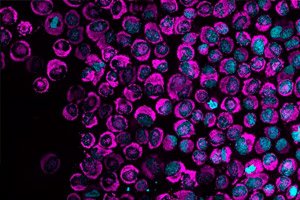
All iLive content is medically reviewed or fact checked to ensure as much factual accuracy as possible.
We have strict sourcing guidelines and only link to reputable media sites, academic research institutions and, whenever possible, medically peer reviewed studies. Note that the numbers in parentheses ([1], [2], etc.) are clickable links to these studies.
If you feel that any of our content is inaccurate, out-of-date, or otherwise questionable, please select it and press Ctrl + Enter.
Cancer cells instantly activate energy production when DNA is compressed and damaged
Last reviewed: 03.08.2025

Cancer cells instantly activate an energy-rich response to physical compression, according to a study published in the journal Nature Communications. This burst of energy is the first documented manifestation of a protective mechanism that helps cells repair damaged DNA and survive the cramped conditions of the human body.
These findings help explain how cancer cells survive in complex mechanical environments, such as crawling through tumor microenvironments, penetrating porous blood vessels, or overcoming shocks in the bloodstream. The discovery of the mechanism could lead to new strategies for “anchoring” cancer cells before they spread.
Researchers at the Centre for Genomic Regulation (CRG) in Barcelona made the discovery using a specialised microscope capable of squeezing living cells to just three microns wide – about thirty times smaller than the diameter of a human hair. They observed that within seconds of being compressed, the mitochondria in HeLa cells rushed to the surface of the nucleus and began pumping in extra ATP, the cells’ molecular energy source.
“This forces us to rethink the role of mitochondria in the human body. They are not just static batteries that power cells, but rather clever ‘rescuers’ that can be called upon in an emergency when a cell is literally pushed to its limits,” says Dr. Sarah Sdelchy, a co-author of the study.
The mitochondria formed such a dense "glow" around the nucleus that the nucleus was squeezed inward. This phenomenon was observed in 84 percent of the compressed HeLa cancer cells, compared with almost zero in the floating, uncompressed cells. The researchers called these structures NAM, for nucleus-associated mitochondria.
To find out what NAMs were doing, the researchers used a fluorescent sensor that lights up when ATP enters the nucleus. The signal increased by about 60% just three seconds after the cells were squeezed.
“This is a clear sign that the cells are adapting to the stress and reconfiguring their metabolism,” explains Dr. Fabio Pezzano, first co-author of the study.
Further experiments showed why this energy boost matters. Mechanical compression stresses DNA, breaking strands and tangling the genome. Cells need ATP-dependent repair complexes to weaken the DNA structure and get to the damage. Compressed cells that received extra ATP repaired their DNA within hours, whereas cells without the extra ATP stopped dividing normally.
To confirm the significance of this mechanism in the disease, the researchers also examined breast tumor biopsies from 17 patients. NAM halos were observed in 5.4% of nuclei at the invasive margin of the tumor, compared with 1.8% in the dense core — a threefold difference.
"The fact that we found this signature in patient tissue confirmed its significance outside the lab," explains Dr. Ritobrata (Rito) Ghose, the study's first co-author.
The researchers were also able to study the cellular mechanisms that enable the mitochondrial “flood.” Actin filaments—the same protein threads that allow muscles to contract—form a ring around the nucleus, and the endoplasmic reticulum pulls the mesh-like “trap” together. This combined arrangement, the study showed, physically holds NAM in place, forming a “halo.” When the researchers treated the cells with latrunculin A, a drug that disrupts actin, NAM formation disappeared and ATP levels plummeted.
If metastatic cells depend on NAM-associated ATP bursts, then drugs that disrupt the scaffold could make tumors less invasive without poisoning the mitochondria themselves or affecting healthy tissue.
"Mechanical stress responses are a poorly understood vulnerability of cancer cells that could open up new therapeutic approaches," said Dr. Verena Ruprecht, co-author of the study.
Although the study focused on cancer cells, the authors point out that this is likely a universal phenomenon in biology. Immune cells passing through lymph nodes, neurons growing processes, and embryonic cells during morphogenesis all experience similar physical stress.
“Where cells are under pressure, the energy surge to the nucleus likely protects the integrity of the genome,” concludes Dr. Sdelchi. “This is an entirely new level of regulation in cell biology, representing a fundamental shift in our understanding of how cells survive physical stress.”
